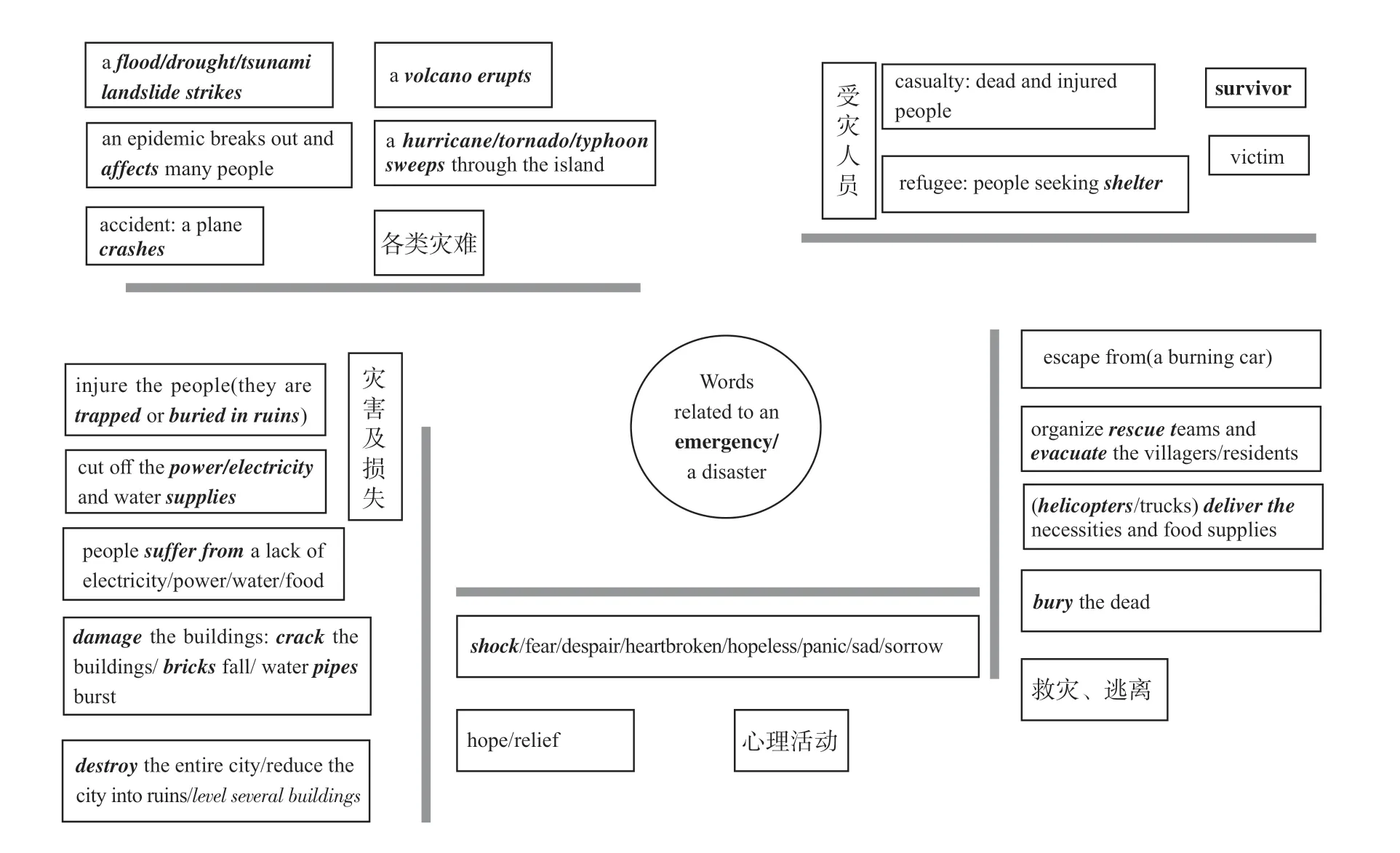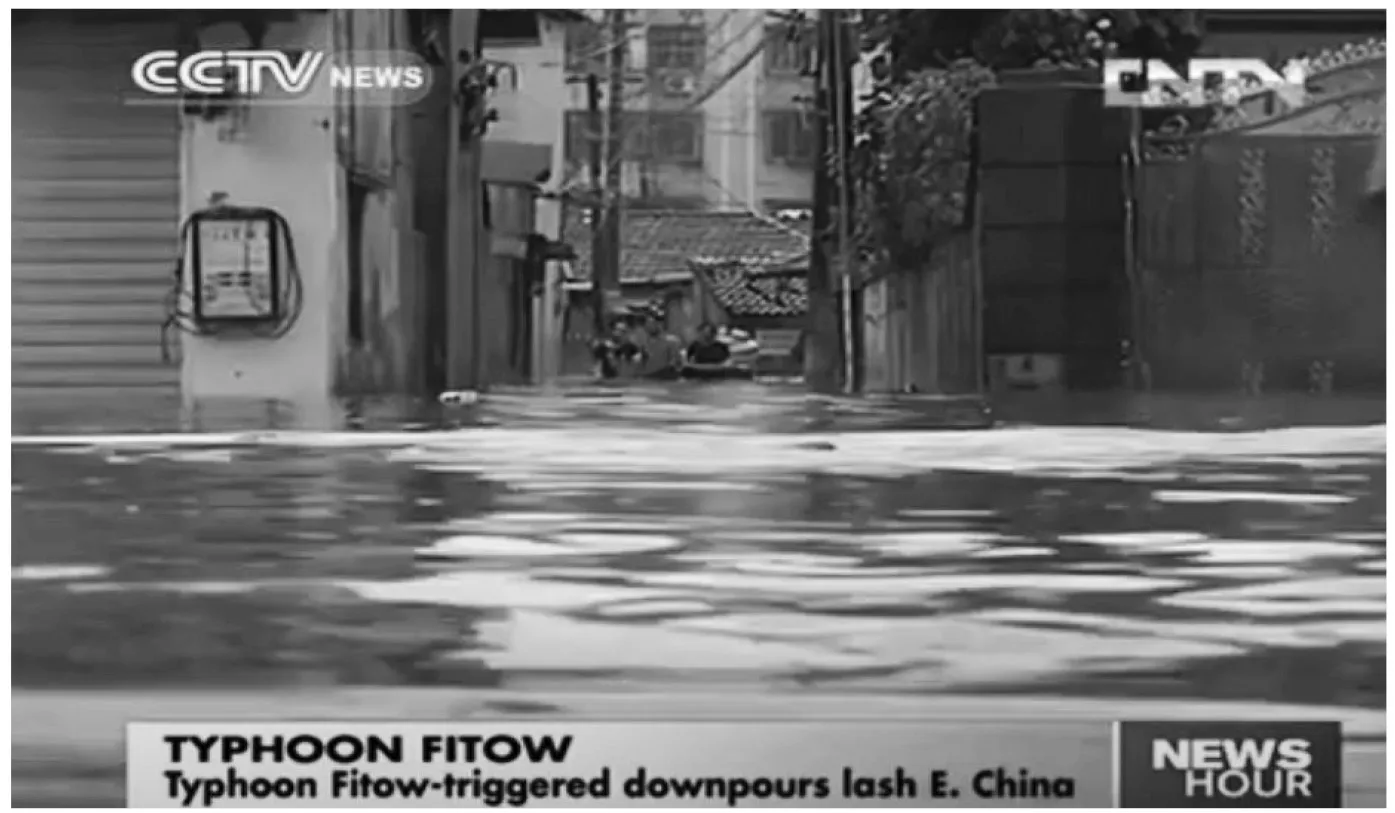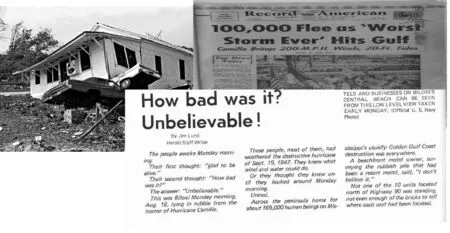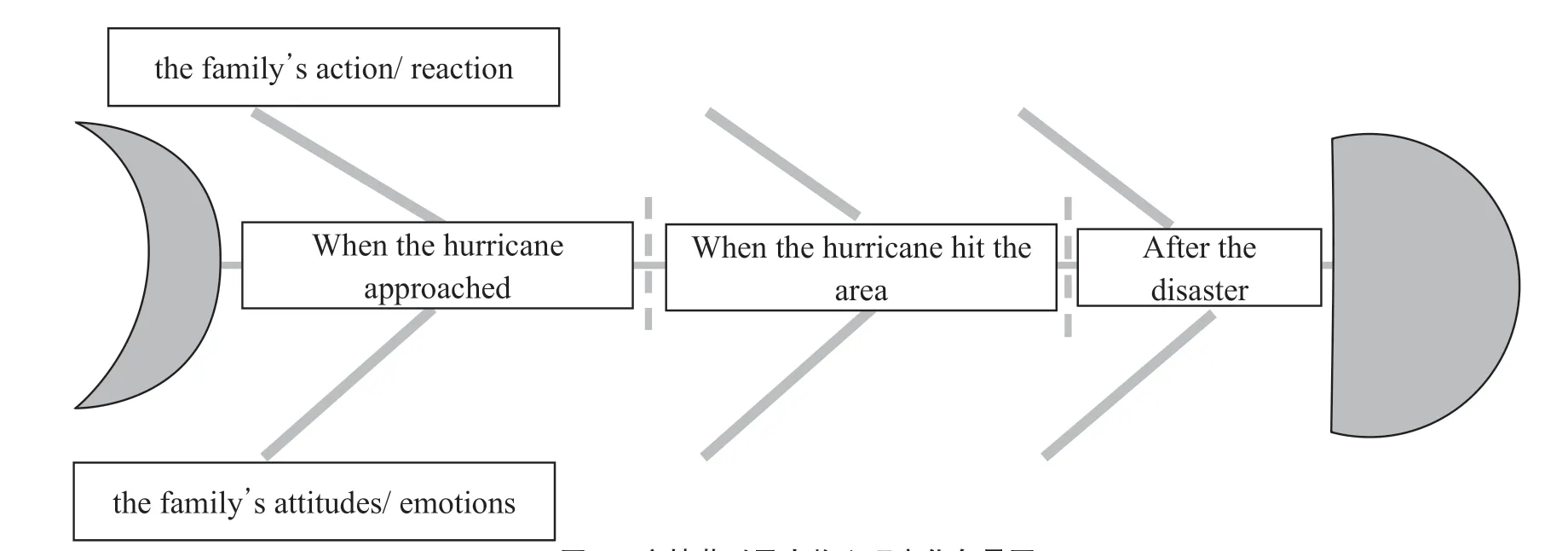基于主题的高中单元拓展阅读教学探索
——以Face to Face with Hurricane Camille 阅读课为例
浙江 牟子龙
拓展性阅读是指在课文内容基础上,对主题进行发散性深入探索与再加工。通过拓展性阅读,学习者可以不受课文内容局限,品鉴不同题材与体裁的文章,从而开拓视野,丰富语言积累。同时,《普通高中英语课程标准(2017 年版2020 年修订)》(以下简称《课程标准》)规定学生在必修阶段的课外阅读量为平均每周不少于1 500 词,可见新课改背景下,《课程标准》对拓展性阅读尤为重视。
一、主题语境
克拉申的“输入假说”指出二语习得者应接触略高于其现有语言技能水平的第二语言输入,因此,选取拓展性阅读材料时应当重点考虑学生对文本主题的熟悉程度,知识储备水平与生活经历。“主题”即《课程标准》中所述“主题语境”,具体为人与自我、人与社会、人与自然三大母题及其下涵盖的人文社科诸领域的子题;而“语境”则可细分为词汇、语言、语法、情境及文化诸项。依据主题意义进行文本阅读,可以激活学习者的已有知识,同时减少语言的枯燥性,增加文本的鲜活性。
二、教学实践
本文以笔者执教的Face to Face with Hurricane Camille拓展性阅读材料阅读课为例,探究如何基于“主题语境”落实拓展性阅读教学,提升学生的英语学科核心素养。
1.教材与学情分析
Face to Face with Hurricane Camille原文由美国作家Joseph P.Blank 撰写,其大意为:飓风Camille 袭击美国南部沿海,John 一家人误判飓风的威力,自信地认为当前的居所能抗住飓风的威力,因而拒绝撤离新家;随着飓风逼近,John 的新家开始停电、漏水,一家人的心情也由原本的自信转为担忧;夜间,飓风登陆,狂风裹挟着巨浪冲上海岸,John 意识到必须尽快撤离至安全地带,但为时已晚,几人逃生时数番受阻,意志低落,John 的精神几近崩溃,陷入自责的情绪;最终,众人在二层卧室的残骸上支起床垫,守护孩童,飓风的威力也终于消减,风止雨歇;次日,众人目睹满目疮痍的家园,心情沉重,却也仍怀希望,开始重建家园。
本文是对2019 年人教版新教材必修一第四单元Natural disasters 的补充,该单元归属于“人与自然”主题,在内容上可被归类为自然灾害的防范与自我保护。本文在文体上属于报告文学(literary journalism)。其题材来自历史事件,人物真实可循,但在描绘上却一改新闻报告的死板之气,修辞运用灵活,能激发读者的共情能力。本文有着非常细腻的场景刻画,尤其是飓风裹挟海潮倒灌内陆、狂风肆虐、暴雨袭击的场景,堪称十分经典。这些细腻的文字描写可以有效服务于新高考读后续写的场景刻画。
在阅读了课本中关于地震、海啸的两篇文章以及Workbook 中的The story of an eyewitness 后,学生有了相应的背景知识,积累了一定的语境词汇(见图1);且笔者所执教的地区常年受台风影响,比起地震与海啸,飓风更能引起学生的共鸣。但该篇文章词汇量较大,生词较多,因此笔者在课前与备课组一同商议,根据学生的水平删去或改写了部分词汇;同时在文章布局上,删去了部分次要情节及作者的文内说明,使文章在结构上更加紧密,也减轻了学生的阅读压力。

图1 灾害话题词汇积累思维导图
2.“主题语境”下教学目标设计
Face to Face with Hurricane Camille是对人教版必修一Natural Disasters 主题的延伸,本单元的语境聚焦人与自然的关系,要求学生通过学习能够深入了解并预防自然灾害。笔者在课前设计了几项预期的教学目标:
After the class,the students will be able to
• Know how John’s family survived the catastrophic hurricane
• Sort out and appreciate verbs and expressions particularly used to describe the ferocity of a powerful storm
• Apply the newly-learnt words and expressions to write about a fierce storm
3.教学步骤
(1)观看视频,引入话题
合理的阅读课导入环节能够有效激发学生探索文本的积极性。本节课以CCTV NEWS 2013 年台风“菲特”的灾后报道视频作为导入,视频内容简短但较为直观,能够有效吸引学生关注课堂内容,通过调动其以往的经历,激发学生的学习兴趣与热情。

图2 台风“菲特”灾害现场报道
[教学片段]
T: Though it was years ago,this destructive typhoon may have left you an unforgettable memory.How would you describe your emotion when the typhoon struck Ningbo?
S1: I felt extremely terrified because the house was shaking.
S2: I was filled with fear and thought it was really the end of the world.
T: Well,this typhoon did cause serious damage to Ningbo when it hit the city like a fierce monster.And can you still remember what was the environment like when it approached,hit and left Ningbo?
S3: The wind blew like a monster and rain poured down.
S4: The house was full of water.And we used the bucket to catch the drips and mopped the floor the whole night.
S5: After the typhoon left,the city was in ruins and there was nothing but water outside.We didn’t have food supply and the power was cut off.We suffered a lot.
【分析与思考】《课程标准》要求通过活动设计激发学生兴趣。比起直接导入或是用图文导入,用视频作为导入可以给学生带来更直观的视觉冲击,更能吸引其注意力。同时,导入环节的第一个问题可以帮助调动学生的记忆,将视频内容与其亲身经历相结合,帮助其迅速进入本课的学习中;第二个问题则主要引导学生思考如何刻画曾体验过的暴风雨场景,并使其思考如何能将细节刻画到位,为之后的语言学习做铺垫。
(2) 启发悬念,激发学生阅读兴趣
设置悬念可促使学生探究文本。1969 年袭击美国南部的飓风Camille 堪称20 世纪最强气旋之一,造成的影响也尤为严重。笔者通过互联网搜寻到了当时的一些照片以及新闻报告以期达到视觉冲击效果,并向学生提问:See how destructive the hurricane was.Many fled and many were killed.Do you think John and his family could survive?And if they could,how?
【分析与思考】不同于“菲特”台风造成的突发性水灾,Camille 对美国南部造成的灾情主要是台风、大雨、大潮带来的,且政府提早发布了预警消息,但原文中的John 一家却选择留在离海边稍远的家中避难,与新闻中十万人撤离形成强烈对比。这些戏剧性的展开能引起学生阅读的兴趣,并思考John 一家人是否能幸免遇难,躲过这场大浩劫。

图3 Camille 灾后画面及新闻报道
(3) 以时间主线梳理文章
Face to Face with Hurricane Camille文本相对较长,有一定阅读难度,但其叙事逻辑紧凑,可主要分为风暴前—风暴来临—风暴过境三个阶段,每个阶段主人公一家人都因风暴威力的变化而产生了不同的心理变化。为帮助学生快速理解文本,教师为学生提供了以下鱼骨图,用于解构文本,分析重要情节以及人物的心理变化,同时要求学生思考以下两个问题:
1.Why did John Koshak decide to stay and face the danger of the hurricane?
2.Why did John Koshak feel a strong sense of guilt sweep over him in Para.10?

图4 主情节以及人物心理变化鱼骨图
【分析与思考】阅读长文本应当泛读与精读有机结合。高中生一般接触较多的是课本内短小精炼的文章,并不习惯阅读这类长文本。但是本篇文本有着线性的时间发展,与主课文The Night the Earth Didn’t Sleep 有着一致的较为明晰的段落划分,即灾难来临—发生—灾后三个阶段。因此,在设计文本阅读的活动时,教师再让学生重复梳理文本结构。直接通过鱼骨图清晰呈现文本的叙事脉络。同时,教师可要求学生只关注于John 一家人在飓风登陆前后的活动与心理变化,以此减小学生的阅读压力。
如前所述,本文属于报告文学,但长于场景以及心理刻画。在John 一家人抗击飓风的过程中,其心理状态由原本的自信转为其后的担忧、惧怕以及近乎绝望。使用鱼骨图既可以从横向表示出心情的转变过程,又可以从纵向上体现出行为与心理微妙的因果关系,可以有效帮助学生厘清脉络,并使其与之共情。
但是学生面对鱼骨图时可能是无措的,故两个问答题可以起到提示与引导的作用。第一问的答案一方面是对上一个活动环节设置的悬念部分的处理,也帮助引导学生整理文本叙事第一阶段,即灾难发生前,John 一家人的行动与其原因。这一问题的答案可从原文概括得出,大致为“The house stood 23 feet above the sea level and 250 yards from the sea,and had stood safe for decades (客观因素).John took it for granted that the house would weather the storm undamaged(主观因素).”
飓风来临时,John 等人抗争的情节是全文中最为曲折复杂的部分。而第10 段John 等人撤离失败返回“危房”的情节则是其一家人的情绪由害怕向无助的转折点,因此对第二问的回答“It was John who made the decision to remain in the house.But now it seemed that they were faced with the threat of death.”可以帮助学生回溯事件起因,并关注到此处John 等人的心情的急剧变化。
整个阅读与讨论过程中,学生需要初步概括出故事的主要情节递进关系。在分享阶段,执教老师通过适当的引领,让学生整理出主线的故事发展与人物内心的心理变化,加深自身对文本的理解。

图5 主情节以及人物心理变化
(4)再读文本,学习语言
课外阅读需要平衡理解与表达。因此,在完成对文本的主旨和部分细节的理解之后,本课的中心转移至对文本内语言的学习。Face to Face with Hurricane Camille在语言描写上尤为细腻,具有很高的学习与效仿价值,尤其在动作和场景描写方面,有着颇多的生动表达。因此,在基本理解全文后,教师可以开始引导学生关注于文本中的场景描写。
[教学片段]
T: What made the Johns so terrified?
S1: The hurricane.
S2: The wind and rain.
T: It was the hurricane that terrified the Johns,or to be specific,the power of hurricane.And the newspaper said,“How bad is it? Unbelievable!”So,can you find supporting evidence to show the unbelievable power of Camille? Please pay attention to the descriptions of wind,rain and damage.
针对所提的问题,教师布置学生以小组形式重读文本,寻找飓风发生前后关于台风、大雨、大潮等场景以及灾后现场的描写。本文对场景的直接描写较多,最后总共整理出9 处场景描写:
1.With gray clouds gathering,rain fell steadily that afternoon.
2.Shortly afterwards,wind and rain started towhipthe house.As the windmountedto a roar,the house began leaking.
3.Theroarof the hurricane now was overwhelming.
4.Ablastof water hit the house,flingingopen the door andshovingthem down the hall.
5.The wind was too strong and the water too deep to flee on foot.
相比于初中物理的教学,高中阶段在知识深度、能力要求上的确有了很大的提升.在初中阶段,学生所学习的物理知识都比较直观且形象,而且很多内容都和学生在实际生活中的体验息息相关.但是高中物理就非常抽象,比如运动学,初中只要研究简单地匀速直线运动,在高中我们要研究更加复杂的匀变速直线运动,而且不仅要描述运动的基本特点,还要结合加速度、初速度等特点,预测运动的发展,最后还要结合力学来分析运动发生的原因.此外,高中阶段还涉及到很多过程复杂的物理情境,很多学生无法明确具体的物理场景,自然也就陷入一头雾水的困境,最终只会备受打击,学习一落千丈.
6.Outside,the wind sounded like the roar of a train passing a few yards away.The houseshudderedand shifted on its foundations while water inched its way up the steps.
7.Watching the waterlapat the steps,John felt a strong guilt sweep over him.
8.They stood shocked at the sight of the community lying in ruins.The beach and highway were littered with bodies and dead animals.
9.They stood shocked at the sight of the community lying in ruins.The beach and highway were littered with bodies and dead animals.The blown down power lines coiled like black spaghetti over the roads.
【分析与思考】理解文本应当是循序渐进的。在理解全文大意的基础上,再寻找关于灾难的描写有助于学生减少阅读障碍。与地震灾害不同,沿海地区台风多发,大部分学生都有所经历,加之教师提醒风雨潮的影响,多数学生可以通过基础词汇推断句意,判定其是否与灾害场景描写有关。但做到这一步,学生只是对环境描写有了一个大致的概念,上述9 处描写中,生词较多(标黑词汇),多数学生并不能完全吃透其中的含义,因此还需要进一步解释。
(5) 猜测词义,处理细节
以小组为活动单位猜测场景描写中出现的生词。设计时,要有的放矢,只要求学生猜测这9 句中出现的动词的词义(见表1).

表1 场景描写中的生词与中英文释义
【分析与思考】由于原作者在多处使用了拟人的修辞手法,尤其是“whip”的英文释义为“blow violently”,尽管在语义上讲得通,但与此处的用法仍旧有着一些差距。因此,学生在猜测词义的过程中有着一定的困难。这一方面证明了学生在阅读稍微有些难度的文本时,不能完全准确理解每处意思,同时也证明了对于文本理解的些许偏差,并不影响整体阅读。
(6)聚焦文本主题意义
本文主要体现“人与自然”的主题语境,之所以选择本篇文章,一方面是为了通过增加“可理解性输入”扩充学生在灾难主题方面的词汇量,另一方面也是为了让学生敬畏自然,学会在灾害来临时保护自己。因此,教师应继续推进对文本的分析,向学生提问:What lesson can you learn from John? And if you were John,what would you do when a storm/typhoon hit? 学生分组并短暂讨论后,教师再请两组学生代表发表自己的看法。
[教学片段]
S1: We should respect the power of nature and run away quickly when there is danger.
T: So,would you hide in other places?
S1: No,my house is really far away from the sea.I will buy some food and water before the storm and hide in my house till the end of the storm.I may also prepare a generator like John.
S2: I think Mother Nature is sometimes merciless.But I think if we make full preparations,we can defeat disasters.
T: Well,that depends.For example,we can’t forecast earthquake,so even if we make preparations,there might be deaths.So,try to learn to protect yourself.
【分析与思考】《课程标准》在“人与自然”主题下,明确提出了要培养学生防灾意识的学习观,因此,读后讨论既是对阅读文本的反思,同时也是在培养学生实际应对灾难时的应急能力,并且为后续的作业布置做出一定的准备。
(7) 作业布置
根据本课所学,运用对风暴的描写,在课后完成一则语篇续写。语篇的大致内容为作者在海滩游玩时,预感到暴风雨将至,正要同朋友回酒店时,突然刮起了大风。这则作业切合高中阶段的读写要求,同时也可有效检测学生对几个优秀表达的运用程度。续写文本如下:
It was a regular day on the beach.Although there were high waves,many people were swimming in the warm water,laughing and trying to stand still as waves hit them hard.It was windy,but the sun was shining bright,so it was so pleasant to dive into the ocean and then lie on the sun-loungers (日光浴椅).
However,a large gray cloud was approaching,and people were leaving the beach to hide from the upcoming storm.I asked one of my friends,“Should we leave? It seems it will rain soon.”However,he was confident that we still had time before the storm began.“Calm down,”he said,“We have at least 30 minutes.There is no need to hurry.”
It turned out that we had no time at all._____________
【分析与思考】课后作业是对教堂教学的延伸与补充。与课内学习任务相关的作业有助于培养学生的迁移能力与创造精神。该读后续写文本较为贴近生活,学生既可以将生活经历转写为文字,同时也能及时巩固课内所学,加工、提取并内化课堂所学的句式与词汇。
四、结语
在当前英语教学“反刍”式深挖课本内容的现实下,基于主题意义开发新颖的阅读补充材料是必要的。而“主题语境”恰好可以成为这样一个主线,架构起一座桥梁,连接课内文本与课外阅读材料。如此一来,学生在阅读的过程中不仅可以强化课内词汇,也能吸收新知,开阔视野。但在这个过程中,教师应该重点关注话题的适切性。
本次课例尝试了基于主题的拓展性文本阅读,是对相关教学实践的一次积极探索,但受限于教师自身水平,仍有诸多不足。例如,在探究主题意义时,未能深挖文本标题Face to Face with Hurricane Camille的深层含义。作者用“face to face”将弱小的“John 一家人”同20 世纪最具破坏性的飓风Camille 置于同一层面,一种强烈的反差跃然纸上,让人不禁反思在自然以及灾害面前,不仅单一的人类个体,即便是整个人类文明也依旧是脆弱的。这种脆弱既使我们敬畏自然,也让我们思考如何同自然和谐相处。同时,因为课程容量有限,无法对词汇作进一步处理,也是遗憾之一。总之,将拓展性阅读融入单元教学是个漫长的过程,需要教师不断探索,扩宽自身的教学理念,并促进学生的思维成长与能力提升。
附录:
拓展性阅读材料原文
Face to Face with Hurricane Camille
By Joseph P.Blank
1.When radio and television warnings sounded throughout that Sunday,John Koshak knew that Hurricane Camille would be bad.Along the coasts of several states,nearly 150 000 people wereevacuated.But,like thousands of others in the coastal communities,John was unwilling to leave his home unless the family was clearly endangered.
2.Johnwas familiar withthe power of a hurricane.Four years earlier,Hurricane Betsy haddestroyedhis former home,which had stood only a few feet above sea level.“We’re elevated 23 feet,”he told his father and Charlie,a friend of his,“and we’re 250 yards from the sea.The place has been here since 1915,and no hurricane has ever bothered it.We’ll probably be as safe here as anyplace else.”The elder Koshak agreed,“If we see signs of danger,we can get out before dark.”
3.The men were fully prepared for the hurricane.Since waterpipesmight bedamaged,they filled bathtubs and buckets.A power failurewas likely,so they checked out batteries for the radio and flashlights,and fuel for the lantern.Meanwhile,a small generator(发电机) was moved into the downstairs hallway.
4.With gray clouds gathering,rain fell steadily that afternoon.The family had an early supper.A neighbor asked if she and her two children could sit out the storm with the Koshaks.
5.It grew dark before seven o’clock.The group stayed together on the first floor.“Keep away from the windows,”John warned,concerned aboutglass flying from stormshattered windows.Shortly afterwards,wind and rain started towhipthe house.As the windmountedto a roar,the house began leaking.With mops,towels and buckets the Koshaks began a struggle against the rapidly spreading water.At 8:30,power failed,and Pop Koshak turned on the generator.
6.The roar of the hurricane now was overwhelming.The house shook,and then the front door started to break away from its frame.John and Charlie put their shoulders against it,but a blast of water hit the house,flingingopen the door andshovingthem down the hall.Charlie licked his lips and shouted to John.“I think we’re in real trouble.That water tasted salty.”The sea had reached the house,and the water was rising by the minute!
7.“Everybody out the back door to the cars!”John yelled.“We’ll pass the children along between us.Count them! Nine!”
8.The children went from adult to adult like buckets in a fire brigade (消防队).But the cars wouldn’t start;the electrical systemshad been killed by water.The wind was too strong and the water too deep to flee on foot.“Back to the house!” John yelled.“Count the children! Nine!”
9.As theyscrambledback,John ordered,“Everybody on the stairs!”Frightened,breathless and wet,the group settled on the stairs,which were protected by two interior walls.Outside,the wind sounded like the roar of a train passing a few yards away.The houseshudderedand shifted on its foundations while water inched its way up the steps.No one spoke.Everyone knew there was no escape;they would live or die in the house.
10.Watching the waterlapat the steps,John felt a strong guilt sweep over him.He didn’t assume that Camille would be sodestructive.He buried his face in handsand silentlyprayed(祈祷) to God,“Get us through this mess,will You?”
11.A moment later,the hurricane,in one mighty swipe,lifted the entire roof off the house.The bottom steps of the staircase fell apart.Immediately,John yelled,“Up the stairs—into our bedroom! Count the kids.” The childrenhuddledin the pouring rain within the circle of adults.However,debris flew as the living-room fireplace and chimneycollapsed.With two walls in their bedroom beginning to fall,John ordered,“Into the television room!” This was the room farthest from the direction of the storm.For an instant,John put his arm around his wife.Janis understood.Shiveringwith the wind,rain and fear,clutchingtwo children to her,she thought,“Dear Lord,give me the strength.We won’t let it win.”
12.The elder Koshak raged silently,frustrated at being unable to do anything to fight Camille.Without reason,hedraggeda mattress (床 垫) from a bedroom into the TV room.At that moment,the wind tore out one wall and put out the lantern.Meanwhile,the house,shuddering and rocking,had moved 25 feet from where it was.It seemed as if the world were breaking apart.
13.“Let’s get that mattress up!”John shouted to his father.“Make it a lean-to against the wind.Get the kids under it.We can support it with our heads and shoulders!”
14.The larger childrensprawledon the floor,with the smaller ones on top of them,and the adults bent over all nine.The floor tilted (倾斜) and another wall fell.Johngrabbeda door still attached to one closet wall.“If the floor goes,”he yelled at his father,“let’s get the kids on this.”
15.In that moment,the wind slightly decreased and the water began receding.The disaster was coming to an end.The Koshaks and their friends hadsurvived.
16.Gulfport people started coming back to their homes,but none of them moved quickly or spoke loudly.Theystood shocked atthe sight of the communitylying in ruins.Thebeach and highway were littered with bodies and dead animals.The blown down power lines coiled like black spaghetti over the roads.
17.By this time,local organizations and,in effect,the entire population of the United States hadcome to the aid ofthe destroyed coast.From hundreds of towns and cities across the country camerescueteams and countless household and medicalsupplies.Camille,meanwhile,hadsweptnorthward,causing severefloods,hugelandslidesand 111 additionaldeathsbefore breaking up over the Atlantic Ocean.
18.Like many other Gulfport families,the Koshaks quickly began reorganizing their lives.The children appeared tosufferno psychological damage from their experience.Butthe blues(忧郁) did occasionallyaffectall the adults.Once,in low spirits,John said to his parents,“I wanted you here so that we would all be together,so you could enjoy the children,but look what happened.”
19.His father comforted,“Let’s not cry about what’s gone.We’ll just start all over.”
20.Later,Grandmother Koshak reflected,“We lost almost all our possessions,but the family came through it.When I think of that,I realize we lost nothing important.”
阅读材料学案(带答案)
1.Understand the content.
a.Why did John Koshak decide to stay and face the danger of the hurricane?
The current house stood 23 feet above the sea level and 250 yards from the sea.And the house had stood safe for decades.In some sense,John took it for granted that the house would weather the storm intact (undamaged).
b.Why did John Koshakfeel a strong guilt sweep over himin Para.10?
He underestimated the destructive power of the hurricane and left the whole family in crushing danger./ It was John who made the decision to remain in the house.But now it seemed that they were faced with the threat of death.
2.Appreciate the language.
Ⅰ.The author makes effective use of verbs in this passage.Appreciate the following verbs and put them into Chinese.
a....wind and rain started towhipthe house.(Para.5)
(风、雨等)猛烈地拍打 (strikes sth sharply)
b.As the windmountedto a roar...(Para.5)
增强;加剧 (increases in intensity)
c....a blast of water hit the house,flingingopen the doorand shovingthem down...(Para.6)
fling:(尤指生气地)扔,掷,抛,丢 (to throw sb./sth.somewhere with force)
shove: 猛推;乱挤;推撞 (to push sb/sth in a rough way) 补充push and shove:推搡
d.As theyscrambledback,John ordered...(Para.9)
(迅速而吃力地)爬,攀登(to move quickly,especially with difficulty,using your hands)
e.The houseshudderedand shifted on its foundations...(Para.9)
强烈震动;剧烈抖动 (to shake very hard)
f.Watching the waterlapat the steps...(Para.10)
(轻柔而有规律地)拍打 (to touch sth gently and regularly,often making a soft sound)
g.The childrenhuddledin the pouring rain...(Para.11)
(人或动物,多因寒冷或害怕)挤在一起 (to gather closely together,because of cold or fear)
h....as the living-room fireplace and chimneycollapsed.(Para.11)
(突然)倒塌,坍塌 (to fall down)
i.Shivering with the wind,rain and fear,clutchingtwo children to her...(Para.11)
(人) 颤抖,哆嗦(因寒冷、恐惧等)to shake slightly because of cold,fright...
j....hedraggeda mattress...(Para.12)
(使劲而吃力地)拖,拉,拽,扯 (to pull sb/sth along with effort and difficulty)
k.The larger childrensprawledon the floor...(Para.14)
伸开四肢坐(或躺)(to sit or lie with your arms and legs spread out)
l.Johngrabbeda door...(Para.14)
抓住 (to take or hold sb./sth.)
Ⅱ.The author is good at the description.Appreciate the following sentences and put them into Chinese.
a.With gray clouds gathering,rain fell steadily that afternoon.
那天下午乌云密布,雨下个不停。
b.Shortly afterwards,wind and rain started to whip the house.As the wind mounted to a roar,the house began leaking.
不久之后,风雨开始拍打着房子。随着风势渐强(狂风咆哮起来),房子开始漏水。
c.The roar of the hurricane now was overwhelming.
飓风怒吼着,已然势不可挡。/ 飓风的咆哮声压倒了一切。
d.A blast of water hit the house,flinging open the door and shoving them down the hall.
一阵浪头袭来,冲开了大门(猛地推开了大门),把他们掀翻在地。
e.The wind was too strong and the water too deep to flee on foot.
风太大,水太深,不能步行逃跑。(狂风大作,大水蔓延,根本没法步行逃离/撤离。)
f.Outside,the wind sounded like the roar of a train passing a few yards away.The house shuddered and shifted on its foundations while water inched its way up the steps.
房子外,狂风(呼啸)听着就像几码外经过的火车的轰鸣声。房子颤抖着,在地基上移动,水慢慢地顺着台阶往上爬。/ 狂风就像在身边呼啸而过的列车一样发出震耳的响声,房屋在地基上晃动移位,此时海水渐渐地漫上了楼梯。
g.Frightened,breathless and wet,the group settled on the stairs,which were protected by two interior walls.
大家跑到靠两堵内墙保护的楼梯上歇着,个个吓得要命,气喘吁吁,浑身湿透。
h.Shivering with the wind,rain and fear,clutching two children to her,she thought,“Dear Lord,give me the strength.We won’t let it win.”
由于风雨和恐惧,她不住地发抖。她一面拉过两个孩子紧贴在自己身边,一面默祷着“亲爱的上帝啊,赐给我力量吧。我们一定不会让它得胜。”
i.Watching the water lap at the steps,John felt a strong guilt sweep over him.
约翰望着海水漫过一级级的台阶,感到一阵强烈的内疚(心中的愧疚无以言表)。
3.Use the language.
结合个人生活经验,尝试用以上表达描写暴风雨的场景片段。
It was a regular day on the beach.Although there were high waves,many people were swimming in the warm water,laughing and trying to stand still as waves hit them hard.It was windy,but the sun was shining bright,so it was so pleasant to dive into the ocean and then lie on the sun-loungers (日光浴椅).
However,a large gray cloud was approaching,and people were leaving the beach to hide from the upcoming storm.I asked one of my friends,“Should we leave as well? It seems it will rain soon.” However,he was confident that we still had time before the storm begins.“Calm down,” he said,“We have at least 30 minutes.There is no need to hurry.”
It turned out that we had no time at all.___________________________________________________________________________________________________________________________________________________________________________________________________________________________________________________________________________________________________________________________
The original version
It turned out that we had no time at all.As soon as my friendutteredthese words,large dropsbegan falling from the dark sky.There waslightning and thunderright above us,and the windblewso hard that we could not hear each other clearly.Itlifted the sand in the airand wasthrowing it into our facessoviolentlythat itbecame impossible to breathe and open our eyes.I think welost all sensesat that moment and instead of hiding somewhere,we ran.The air was whirling around usand we felt the sand and small rockshitting our legs.Meanwhile,I feltlarge,quick drops going down my spine,arms,and legs and washing the salt that ate into my hair.Clouds were moving across the skyin such a way that it seemed the light was coming from the north instead of the west where it should be.We cried to each other some incomprehensible phrases,but it was useless to speak at that moment — all we could hear was the stormragingabove.At one point,I realized that I was directly facing nature andits beautiful yet threatening power.I knew no one could help me because everyone was thinking only about hiding in the nearest house or shop.
读后练习题(带答案)
Ⅰ.语法填空
1.In 1969,several coastal states were affected (affect)by Hurricane Camille.The disastrous (disaster) hurricane is one of the most powerful (power) storms striking America,bringing death and destruction (destroy) that haunted the survivors (survive) for the rest of their life.
2.When Hurricane Camille approached,nearly 150 000 people were forced to evacuate (evacuate).However,John was unwilling (willing) to leave his home.“No hurricane has bothered (bother) this place since 1915,”he told his father,believing they would probably be as safe there at their new house as anyplace else.
3.As the wind strengthened (strength),the house began leaking.The Koshaks began a struggle against the rapidly spreading water.
4. Burying (bury) his face in hands,he silently prayed to God.
5.When the storm was over,the community was left(leave) in ruins.6.It was a shocking (shock) sight of complete devastation.
7.This experience appeared to have no actual effects on the children and cause no psychological damage to them.
8. To a great extent,it was the adults who/ that occasionally suffered from the blues.
9.If they didn’t stick together,the Koshaks may have ended up dying (die) in the hurricane.
Ⅱ.句子翻译
1.Colin 猛地翻过身去,把脸埋在枕头里 (bury)。
Colin flung himself over so his face______________________________the pillow.
2.他猛地把门打开,怒气冲冲地走了进来,脸上露出了一贯的怒容 (fling)。
He ______________________________ and_____________________________,the usual scowl nailed to his face.
3.当他的妻子去世时,Mr.Craven 的世界崩塌了(collapse)。
Mr.Craven’s world______________________________when his wife was dead.
4.随着紧张情绪的加剧,人群变得愈发嘈杂。但好在大家相互之间没有争斗,也没有推搡 (tension;mount;push and shove)。
As _________________________________,the crowds became noisier.But there were no fights and______________________________.
5.阵阵狂风吹打着房子,Kris 蜷缩在房间的一个角落,害怕得发抖 (whip;huddle;shiver/shudder)。
When ______________________________,Kris__________________________________in a corner of the room,______________.
6.车子一下子着火了,她急忙从车里爬了出来(scramble)。
She _________________________________________ the vehicle as it burst into flames.
7.海浪拍打着我们的脚,使我们充满了温柔 (lap;tenderness)。
The waves _______________________________ around our feet,_______________________________________.
8.我要趁着太阳出来的时候,好好感受一下阳光/抓住阳光 (grab)。
I’ve got to _______________________________ while it’s out.
9.她站在那儿,手里紧握着花。(clutch)
She stood there,______________________________the flowers in her hand.
10.不知什么东西击中了她,把她打趴在地上。Something unknown hit her and sent her________________________(sprawl) to the ground.
句子翻译参考答案
1.Colin 猛地翻过身去,把脸埋在枕头里 (bury)。
Colin fulng himself over so his face was buried in the pillow.
2.他猛地把门打开,怒气冲冲地走了进来,脸上露出了一贯的怒容 (fling)。
He flung the door open and stormed in,the usual scowl nailed to her face.
3.当他的妻子去世时,Mr.Craven 的世界崩溃了(collapse)。
Mr.Craven’s world had collapsed when his wife was dead.
4.随着紧张情绪的加剧,人群变得愈发嘈杂。但好在大家相互之间没有争斗,也没有推搡 (tension;mount;push and shove)。
As the tension mounted,the crowds became noisier.But there were no fights and no pushing or no shoving.
5.阵阵狂风吹打着房子,Kris 蜷缩在房间的一个角落,害怕得发抖 (whip;huddle;shiver/shudder)。
When gusts of fierce wind whipped the house,Kris huddled in a corner of the room,shivering/ shuddering with fear.
【表达积累】Gusts of wind whipping the house,Kris huddled in a corner of the room and shivered/shuddered with fear/fright.
6.车子一下子着火了,她急忙从车里爬了出来 (scramble)。
She scrambled out of the vehicle as it burst into flames.
7.海浪拍打着我们的脚,使我们充满了温柔 (lap;tenderness)。
The waves lapped around our feet,fliling us with tenderness.
8.我要趁着太阳出来的时候,好好感受一下阳光/抓住阳光 (grab).
I’ve got to grab the sunshine while it’s out.
9.她站在那儿,手里紧握着花。(clutch)。
She stood there,clutching the flowers in her hand.
10.不知什么东西击中了她,把她打趴在地上。
Something hit her and sent her sprawling to the ground.

